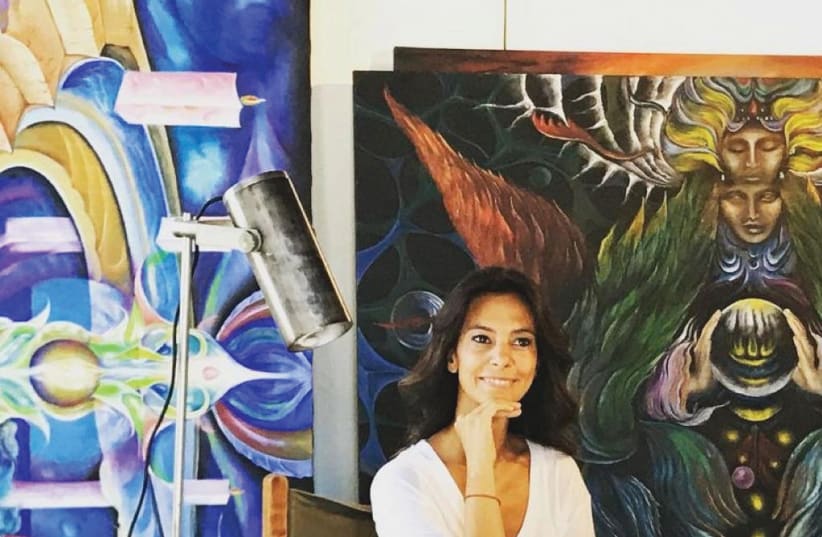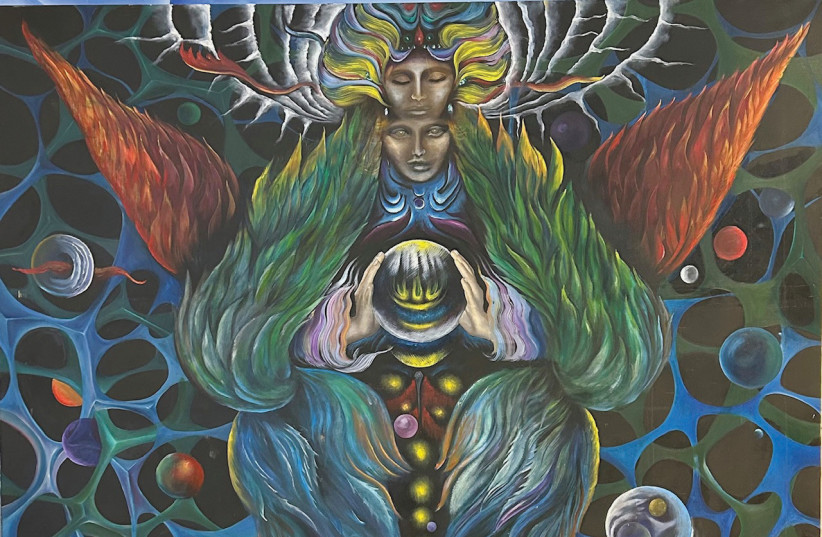Painter Lea Gul’s first solo exhibition in Israel – opening the evening of May 15 at the ZOA House in Tel Aviv – marks a new chapter in the fascinating life story of a religious Jewish Jerusalemite raised as a secular Muslim in Istanbul.
A mother of four who looks like a fashion model even though she just turned 51, Lea overcame many obstacles to get where she is today. 
Though many students in her Istanbul high school were Jewish, she says, and all her boyfriends were Jewish, her pull to Judaism was precipitated by nearly dying in a car crash in 2000.
“I should have died, and I started wondering why I didn’t,” she says.
That question led her on a spiritual search, and in 2002 she told her parents that she wanted to move to India.
Her mother suggested that first she should read three holy books “to see if I could find the source of the power that protected me from death.”
Converting to Judaism
She was very taken by the Torah’s philosophy and started to research Judaism. Two years later, while visiting Anne Frank’s house in Amsterdam, she made her decision to convert. “That’s what I wrote in the guest book on the way out,” she recalls.
At home in Istanbul, she had two passions: competitive horseback riding and painting. She had a painting studio where she taught adults and children, and hosted evening discussions with art historians and philosophers. She had four solo and two group exhibitions between 1999 and 2005.
Gradually, her mother took over the classes so that Lea (then named Konca, Turkish for “rosebud”) could delve into Jewish learning. Her mother was fully supportive, happy that her daughter had found something to believe in.
But she couldn’t convert in Turkey because Ottoman law forbids Jews from converting Muslims. In 2005, she decided to live in the Amsterdam Jewish community and convert there, but first she had an exhibition of her horse paintings.
During the exhibition, she met Leon, her future husband. Leon was Jewish and had been recommended to her as someone who could help find out about the artistic symbol of almond blossoms in the Tabernacle, a topic that intrigued her.
When they met on May 5, it was love at first sight. Immediately, they began studying together. He invited her to Shabbat dinner at his family’s home a week later, and that night they got engaged.
In the summer, Orthodox author and educator Dr. Joel Wolowelsky from New York visited Istanbul. He and the Chabad rabbi in Istanbul, Rabbi Mendy Chitrik, who had been assisting her in her Jewish studies, arranged for Konca to complete her conversion in Atlanta, Georgia. She went in September and returned three and a half months later as a Jew named Lea.
She chose that name, she explains, because the biblical character of Lea “is powerful and sees beyond the reality.”
After marrying Leon in June, Lea soon became pregnant with twin girls. Continuing to leave both art and dressage to the side, she started teaching Torah classes.
“We opened our house to everyone on Shabbat. I had another daughter 13 months later, and yet we never stopped opening our house, to serve God,” she says.
Three years after her third daughter was born, Lea gave birth to a son. She continued teaching Torah and hosting Shabbat guests, but gradually “I began to see that people were not immersing themselves in the knowledge; they were only learning intellectually. I felt it should not be like this.”
In 2017, she opened an aliyah file at the Israeli Embassy, but her husband was not willing to go. The marriage had become troubled by this point, and the couple divorced in 2020. The only stipulation Lea made in the negotiations was that she must be able to take her children to live in Israel.
“I had to make aliyah,” she explains, “because Istanbul is a very secular society. If I wanted to raise my children in an Orthodox way, I had to go to Israel. They had never even been to a birthday party in Istanbul because all the parties are held on Shabbat.”
With an intermarriage rate of about 80%, she knew when the time came she would not be able to find her children appropriate spouses.
Although many Turkish immigrants have settled in Ra’anana and Haifa, she chose Jerusalem when she arrived in Israel in August 2021. “The first time I saw the golden stones, I knew had to live here.”
HER FATHER passed away in 2019 and her mother in March 2021. Needing to support herself, she put her full energy into painting, a passion she had returned to in 2015, using a style she learned from surrealist Turkish painter Erol Denec, a protégé of Austrian painter Ernst Fuchs, co-founder of the Vienna School of Fantastic Realism.
“I felt if Hashem gave me this talent, I should use it,” she says.
“My work now is an unlimited way of seeing beyond reality. With Torah, I was able to express what is inside of me.”
One day, a real estate agent who had come to show Lea’s apartment to a prospective client saw Lea’s paintings and told her friend Vered Daya, from the ZOA Gallery, about Lea’s talent.
Veteran art world publicist Michal Sadan, a former curator, was brought in to help make arrangements for a show. Excited about Lea’s potential, Sadan engaged Galit Zimbalist to curate the ZOA exhibition, which runs through the end of June.
“I know that she will find her standing in the Israeli world of art because her work has powerful energy, her paintings are fascinating, and the spectators are deeply moved,” Zimbalist writes in her text for the “Unmasked before the Forces of Creation” show.
“Lea paints her pure emotions, using an intense multicolored palette, layers of color, and the precision of the boundaries that create the sense of virtual reality in the story.
“From inner listening and an intuitive connection, she develops a personal and unique style, she investigates her past and contemplates her future as a creative woman in a new and challenging place.”
Indeed, the road Lea has followed has been challenging, but she and her children – now 16, 16, 15, and 12 – believe they’ve found their destination. ■
LEA GUL, 51 FROM ISTANBUL TO JERUSALEM, 2021

